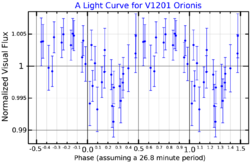Astronomy:G 99-47
Coordinates: ![]() 05h 56m 25.47s, +05° 21′ 48.6″
05h 56m 25.47s, +05° 21′ 48.6″
| Observation data Equinox J2000.0]] (ICRS) | |
|---|---|
| Constellation | Orion |
| Right ascension | 05h 56m 25.47s[2] |
| Declination | +05° 21′ 48.6″[2] |
| Apparent magnitude (V) | 14.105[3] |
| Characteristics | |
| Spectral type | DAP8.9[4] |
| Apparent magnitude (B) | 14.69[2] |
| Apparent magnitude (V) | 14.10[2] |
| Apparent magnitude (R) | 14.0[2] |
| Apparent magnitude (I) | 13.6[2] |
| Apparent magnitude (J) | 12.930 ± 0.022[2] |
| Apparent magnitude (H) | 12.720 ± 0.025[2] |
| Apparent magnitude (K) | 12.653 ± 0.024[2] |
| Astrometry | |
| Proper motion (μ) | RA: -444.685[5] mas/yr Dec.: -925.140[5] mas/yr |
| Parallax (π) | 123.1989 ± 0.0170[5] mas |
| Distance | 26.474 ± 0.004 ly (8.117 ± 0.001 pc) |
| Absolute magnitude (MV) | 14.59[3][6][note 1] |
| Details | |
| Mass | 0.71 ± 0.03[3] M☉ |
| Radius | 0.011[3][note 2] R☉ |
| Surface gravity (log g) | 8.20 ± 0.05[3] cgs |
| Temperature | 5790 ± 110[3] K |
| Age | 3.97[4][note 3] Gyr |
| Other designations | |
| Database references | |
| SIMBAD | data |
G 99-47 (V1201 Orionis) is a nearby degenerate star (white dwarf) of spectral class DAP8 (DAP8.9,[4] or DAP8.7[3]), the single known component of the system, located in the constellation Orion. G 99-47 is probably the tenth closest white dwarf, followed by Gliese 293, Gliese 518 and Gliese 915.
The mass of G 99-47 is 0.71±0.03 Solar masses;[3] its surface gravity is 108.20 ± 0.05 (1.58 · 108) cm·s−2,[3] or approximately 162 000 of Earth's, corresponding to a radius 7711 km, or 121% of Earth's. Its temperature is 5790 ± 110 K,[3] almost like the Sun's; its cooling age, i. e. age as degenerate star (not including lifetime as main sequence star and as giant star) is 3.97 Gyr.[4] Due almost equal to the Sun's temperature, GJ 1087 should appear almost the same white color as the Sun. The white dwarf has a strong magnetic field, with measured vertical component near surface equal to 560 T.[7]
See also
Notes
References
- ↑ Brinkworth, Carolyn S.; Burleigh, Matthew R.; Lawrie, Katherine; Marsh, Thomas R.; Knigge, Christian (August 2013). "Measuring the Rotational Periods of Isolated Magnetic White Dwarfs". The Astrophysical Journal 773 (1): 47. doi:10.1088/0004-637X/773/1/47. Bibcode: 2013ApJ...773...47B.
- ↑ 2.00 2.01 2.02 2.03 2.04 2.05 2.06 2.07 2.08 2.09 2.10 2.11 2.12 2.13 2.14 2.15 2.16 2.17 2.18 "V* V1201 Ori -- White Dwarf". Centre de Données astronomiques de Strasbourg. http://simbad.u-strasbg.fr/simbad/sim-id?Ident=GJ+1087.
- ↑ 3.00 3.01 3.02 3.03 3.04 3.05 3.06 3.07 3.08 3.09 3.10 3.11 Holberg, J. B.; Sion; Oswalt; McCook; Foran; Subasavage (2008). "A New Look at the Local White Dwarf Population". The Astronomical Journal 135 (4): 1225–1238. doi:10.1088/0004-6256/135/4/1225. Bibcode: 2008AJ....135.1225H. https://commons.erau.edu/publication/886.
- ↑ 4.0 4.1 4.2 4.3 4.4 Sion, Edward M.; Holberg; Oswalt; McCook; Wasatonic (2009). "The White Dwarfs within 20 Parsecs of the Sun: Kinematics and Statistics". The Astronomical Journal 138 (6): 1681–1689. doi:10.1088/0004-6256/138/6/1681. Bibcode: 2009AJ....138.1681S.
- ↑ 5.0 5.1 5.2 Brown, A. G. A. (2021). "Gaia Early Data Release 3: Summary of the contents and survey properties". Astronomy & Astrophysics 649: A1. doi:10.1051/0004-6361/202039657. Bibcode: 2021A&A...649A...1G. Gaia EDR3 record for this source at VizieR.
- ↑ 6.0 6.1 Yale Trigonometric Parallaxes, Fourth Edition (van Altena+ 1995)
- ↑ Bagnulo, Stefano; Landstreet, John D. (2020), "Discovery of six new strongly magnetic white dwarfs in the 20 pc local population", Astronomy & Astrophysics 643: A134, doi:10.1051/0004-6361/202038565, Bibcode: 2020A&A...643A.134B
 |


